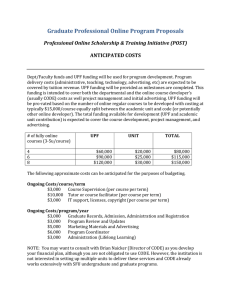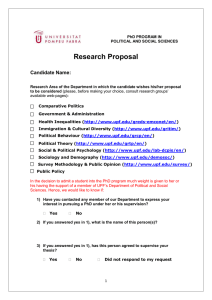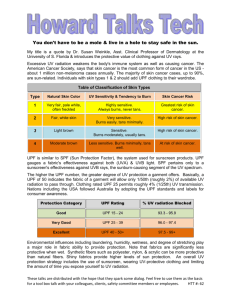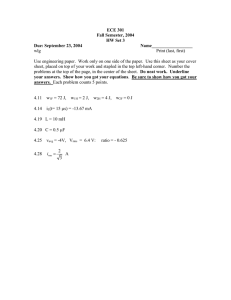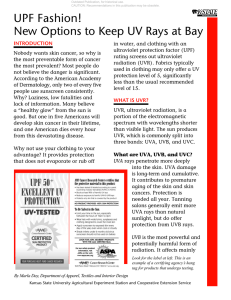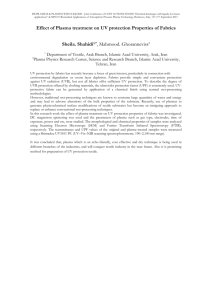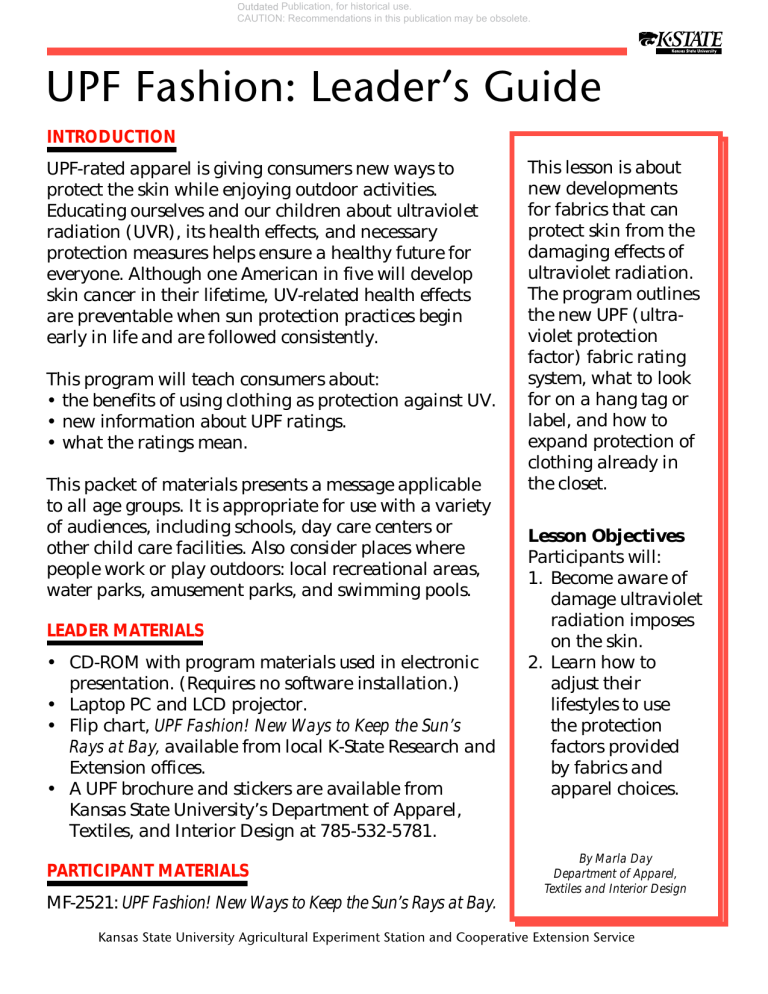
Outdated Publication, for historical use.
CAUTION: Recommendations in this publication may be obsolete.
UPF Fashion: Leader’s Guide
INTRODUCTION
UPF-rated apparel is giving consumers new ways to
This
lesson
aboutwhile
new developments
for fabrics
that can
protect
theisskin
enjoying outdoor
activities.
protect
us from
the damaging
effects
of ultraviolet
radiation.
Educating
ourselves
and our
children
about ultraviolet
The
program
outlines
new UPF
(ultraviolet
protection facradiation
(UVR),
itsthe
health
effects,
and necessary
tor)
fabric rating
system,
whatensure
to lookafor
on a hang
tag for
or laprotection
measures
helps
healthy
future
bel,
and how
to expandone
theAmerican
protection in
of the
already
everyone.
Although
fiveclothing
will develop
in
thecancer
closet. in their lifetime, UV-related health effects
skin
are preventable when sun protection practices begin
Introduction
early in life and are followed consistently.
UPF-rated apparel is giving consumers new ways to protect the
skin
enjoying
activities. Educating
Thiswhile
program
will outdoor
teach consumers
about: ourselves
and
our
childrenofabout
(UVR),
its health
• the
benefits
usingultraviolet
clothing radiation
as protection
against
UV.
effects,
and
necessary
protection
measures
helps
ensure
a
• new information about UPF ratings.
healthy
for everyone.
• what future
the ratings
mean. Although one American in five
will develop skin cancer in their lifetime, UV-related health effects
preventable
when sun
protection
practices
begin
This are
packet
of materials
presents
a message
applicable
early
lifegroups.
and are It
followed
consistently.
to allinage
is appropriate
for use with a variety
of audiences, including schools, day care centers or
This
program
will teach
consumers
about: places where
other
child care
facilities.
Also consider
*people
the benefits
as protection
against UV.
work of
orusing
playclothing
outdoors:
local recreational
areas,
*water
new information
about
UPF
ratings.
parks, amusement parks, and swimming pools.
* what the ratings mean.
LEADER MATERIALS
This packet of materials presents a message applicable to all
• CD-ROM
with
program
materials
in electronic
age
groups. The
packet
is appropriate
forused
use with
a variety
presentation.
(Requires
noday
software
installation.)
of audiences,
including
schools,
care centers
or other child
•
Laptop
PC
and
LCD
projector.
care facilities. Also consider places where people work or play
• Flip chart,
UPF Fashion!areas,
New Ways
Keepamusement
the Sun’s
outdoors:
local recreational
water to
parks,
Rays
at swimming
Bay, available
parks,
and
pools.from local K-State Research and
Extension offices.
• A UPF
brochure and stickers are available from
Lesson
Objectives
Kansas State
Participants
will: University’s Department of Apparel,
Interior
785-532-5781.
1. Textiles,
Becomeand
aware
of the Design
damageat
ultraviolet
radiation imposes on the skin.
PARTICIPANT
2.
Learn howMATERIALS
to adjust their lifestyles to use the protection
factors
provided
by fabrics
apparel
choices.
MF-2521:
UPF Fashion!
Newand
Ways
to Keep
the Sun’s Rays at Bay.
This lesson is about
new developments
for fabrics that can
protect skin from the
damaging effects of
ultraviolet radiation.
The program outlines
the new UPF (ultraviolet protection
factor) fabric rating
system, what to look
for on a hang tag or
label, and how to
expand protection of
clothing already in
the closet.
Lesson Objectives
Participants will:
1. Become aware of
damage ultraviolet
radiation imposes
on the skin.
2. Learn how to
adjust their
lifestyles to use
the protection
factors provided
by fabrics and
apparel choices.
By Marla Day
Department of Apparel,
Textiles and Interior Design
Kansas State University Agricultural Experiment Station and Cooperative Extension Service
Outdated Publication, for historical use.
CAUTION: Recommendations in this publication may be obsolete.
UPF Fashion! Leader’s Guide
NEW FRONTIERS IN UVR PROTECTION
AATCC TM 183-1999 Transmittance or
Blocking of Erythemally Weighted
Ultraviolet Radiation Through Fabrics:
the performance test used to verify
fabric properties.
Glare marathon: lets in less than 3
percent of UV light. A spectrophotometer
measures the transmission of UVR and
simulates sunlight exposure on a textile
under controlled conditions.
Wash out: clothes must retain sun
protection after 40 wash cycles. The
test measures the percentage change
before and after washing to simulate
two years of seasonal use.
Chlorine zap: similar to wash tests, but
tested in chlorinated water. Swimsuits
are tested when fabric or apparel claims
sun or UV protection.
ASTM D 6544-00 Standard Practice for
Preparation of Textiles Prior to UV
Transmission Testing: describes procedure
for exposing textiles to laundering,
simulated sunlight, and chlorine prior
to testing for UV transmission.
ASTM D 6603-00 Standard Guide
for Labeling of UV-Protective Textiles:
describes the labeling requirements
for textile products intended for the
protection of humans from UVA and
UVB radiation. It supplements Care
Labeling Rules monitored by the Federal
Trade Commission.
Australian UPF Standard AS/NZ 4399:1996
The Australian Radiation Laboratory
was the first to develop standards for
testing UV protection in fabrics used for
clothing, and coined the term UPF. Their
standard served as a model for the U.S.
industry until 2001. Manufacturers may
still be in transition from using this
procedure for product information and
care labels to the new ASTM standards.
The standards are now voluntary,
but could become mandatory if not
adopted by the industry. The American
Association of Textile Chemists and
Colorists and the American Society for
Testing and Materials developed these
specifications to determine whether a
material, product, system, or service
meets specified requirements.
Consumers should look for the test
methods listed on product information,
keeping in mind that tests only relate
to the fabric: Design, fit, and the amount
of body covered are not considered but
will affect the protection level.
UPF ratings: What the numbers tell us
Classification Category: textiles or
fabrics are tested and assigned a UPF
classification category of Good, Very
Good, or Excellent Protection, based
on test results.
Approximate Average Percent UV Blocked:
the range of UV values the fabric is
able to block. No fabric provides 100
percent protection.
Outdated Publication, for historical use.
CAUTION: Recommendations in this publication may be obsolete.
UPF Fashion! Leader’s Guide
UPF Values for Labeling: the distribution of
the values by category. Manufacturers
that give a specific UPF value must
round down to numerical increments
of five (15, 20, 25 ... up to 50+). For
example, if the UPF of a product is 38,
the manufacturer must report the value
as a UPF of 35, not 40.
(between 15 and 50+). Labels must also
include the statement “Product labeled
according to ASTM D 6603.”
UPF Range for Classification Category: range
of UPF scores within each category.
OTHER PRODUCTS ON THE HORIZON
Check statements made by manufacturers
for reliability of test methods. UV
protected and UPF protected do not
mean the same thing. UV protected
clothing does not undergo the same
testing as UPF rated clothing.
UPF rated garment labels must include
the classification category (Good, Very
Good, or Excellent) and the UPF value
Look for the label below. It is an example of a certifying
agency’s hang tag for tested products.
FDA approval is needed for products
that claim a medical benefit. FDAapproved fabrics are guaranteed to
reduce UV radiation by at least 97 percent.
Coral sunscreens
A sunscreen using coral’s natural
defense against UV could be on the
market by 2005, according to scientists
at the Australian Institute of Marine
Science. The sunscreen is the first of
its type and is based on the natural
ultraviolet blocking compound found
in coral reefs.
Algae cellular repair
Published in the Proceedings of the
National Academy of Sciences, the
research works with nature’s least
refined organisms – l owly plankton.
The tiny algae spend their lives at the
ocean surface, constantly exposed to
UVR. Over time, the algae developed
a molecular shield against harmful
light in the form of phytolyase, an
enzyme that helps them repair
DNA damage.
Scientists have been able to reduce
45 percent of the harmful effects to
the skin in controlled experiments
replicating the phytolyase enzyme.
Products containing phytolyase
enzyme should be in stores soon.
Outdated Publication, for historical use.
CAUTION: Recommendations in this publication may be obsolete.
OTHER RESOURCES AND IDEAS
• Additional programs on skin cancer protection have been developed.
Contact K-State Research and Extension county offices for program
materials and a tabletop display – Fry Now, Pay Later – by Deanna Munson.
Publications include MF-2410 Fry Now, Pay Later - Participant; MF-2410A Fry
Now, Pay Later - Contract; and MF-2411 Fry Now, Pay Later - Teaching Guide.
• Contact The American Academy of Dermatology for pamphlets about UV
related skin damage at www.aad.org.
• Contact the American Cancer Society and schedule the Mobile Classroom
for a visit to your city at www.cancer.org/state/heartland/index.html
or 800-606-0227.
• Schools and child care facilities may contact the following agencies for
educational programs and instructional materials:
• U.S. Environmental Protection Agency Sun Wise School Program at
www.epa.gov/sunwise/index.html.
• AMC Cancer Research Center for instructional materials and a
guide to assist schools in developing and promoting sun-safe behaviors
at www.amc.org.
End-of-Program Evaluation
At the end of the program, ask participants to raise their hands if they agree or
disagree with the statements listed below. Record the number of participants
attending the program, and the number of hands raised for each statement.
Strongly
Disagree
Number attending program ______
I learned something I can use in my home.
I have the information I need to make
decisions about fabrics to protect the skin
from UV.
I plan to use the information and model
sun-safe behavior to family, co-workers,
and friends.
I will recommend this information
to someone I know.
Disagree
Agree
Strongly
Agree
Please send this form to Marla Day, Textile Associate, ATID, Kansas State University,
236B Justin, Manhattan, KS 66506.
Publications from Kansas State University may be freely reproduced for educational purposes. All other rights reserved. In either case,
credit Marla Day, UPF Fashion: Leader's Guide, Kansas State University, August 2001.
Kansas State University Agricultural Experiment Station and Cooperative Extension Service, Manhattan, Kansas
MF-2522
AUGUST 2001
It is the policy of Kansas State University Agricultural Experiment Station and Cooperative Extension Service that all persons shall have equal
opportunity and access to its educational programs, services, activities, and materials without regard to race, color, religion, national origin, sex, age
or disability. Kansas State University is an equal opportunity organization. Issued in furtherance of Cooperative Extension Work, Acts of May 8 and
June 30, 1914, as amended. Kansas State University, County Extension Councils, Extension Districts, and United States Department of Agriculture
Cooperating, Marc A. Johnson, Director.

